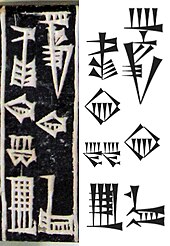Ergative case

Ingrammar,theergative case(abbreviatederg) is thegrammatical casethat identifies anominal phrase[2]as theagentof atransitive verbinergative–absolutive languages.[3]
Characteristics
[edit]In such languages, the ergative case is typicallymarked(mostsalient), while theabsolutive caseis unmarked. Recent work incase theoryhas vigorously supported the idea that the ergative case identifies the agent (the intentful performer of an action) of a verb.[4]
InKalaallisut(Greenlandic) for example, the ergative case is used to mark subjects of transitive verbs and possessors of nouns. Thissyncretismwith thegenitiveis commonly referred to as therelativecase.
Nez Percehas a three-way nominal case system with both ergative (-nim) andaccusative(-ne) plus an absolute (unmarked) case for intransitive subjects:hipáayna qíiwn‘the old man arrived’;hipáayna wewúkiye‘the elk arrived’;wewúkiyene péexne qíiwnim‘the old man saw an elk’.
Sahaptinhas an ergative noun case (with suffix-nɨm) that is limited to transitive constructions only when the direct object is 1st or 2nd person:iwapáatayaaš łmámanɨm‘the old woman helped me’;paanáy iwapáataya łmáma‘the old woman helped him/her’ (direct);páwapaataya łmámayin‘the old woman helped him/her’ (inverse).
In languages with an optional ergative, the choice between marking the ergative case or not depends on semantic or pragmatics aspects such as marking focus on the argument.[5]
Other languages that use the ergative case areGeorgian,Chechen,and otherCaucasian languages,Mayan languages,Mixe–Zoque languages,Wagimanand otherAustralian Aboriginal languagesas well asBasque,BurushaskiandTibetan.Among allIndo-European languages,onlyYaghnobi,Kurdish languagevarieties (includingKurmanji,ZazakiandSorani)[6]andPashtofrom theIranian languagesandHindi/Urdu,along with some otherIndo-Aryan languages,are ergative.
The ergative case is also a feature of someconstructed languagessuch asNa'vi,IthkuilandBlack Speech.
See also
[edit]Citations
[edit]- ^Edzard, Dietz-Otto(2003).Sumerian Grammar.BRILL. p. 36.ISBN978-90-474-0340-1.
- ^Loos, Eugene."Glossary of linguistic terms".LinguaLinks Library 5.0 Plus.Archived fromthe originalon March 4, 2016.RetrievedSeptember 27,2013.
- ^Haspelmath, Martin.2022. Ergative, absolutive, accusative and nominative as comparative concepts. In Iomdin, Leonid & Milićević, Jasmina & Polguère, Alain (eds.), Lifetime linguistic inspirations: To Igor Mel’čuk, 201–213. Frankfurt: Peter Lang. (doi:10.5281/zenodo.7625026) (https://zenodo.org/record/7625026)
- ^Woolford, Ellen."Lexical Case, Inherent Case, and Argument Structure".Feb 2005.
- ^William B. McGregor(1 July 2010). "Optional ergative case marking systems in a typological-semiotic perspective".Lingua.120:1610–1636.doi:10.1016/J.LINGUA.2009.05.010.ISSN0024-3841.WikidataQ122816430.
- ^Theodora Bynon.1979. The Ergative Construction in Kurdish.Bulletin of the School of Oriental and African StudiesVol. 42, No. 2:211-224.
